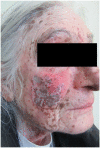Can it make me white again? A case report of 88% phenol as a depigmenting agent in vitiligo
- PMID: 33680467
- PMCID: PMC7900787
- DOI: 10.1177/2050313X21993307
Can it make me white again? A case report of 88% phenol as a depigmenting agent in vitiligo
Abstract
Vitiligo is the most common depigmenting disorder. However, therapies prove to be time-consuming, costly, or slow to show efficacy. Here, we present a case of a 74-year-old female with vitiligo who underwent full-body depigmentation treatment 50 years ago. Brown patches of repigmentation appeared on the patient's face and arms and were eventually treated with 88% phenol. Patient was later switched to compounded 3% glutathione cream for a more sustained effect. Phenol was an accessible, economical, and easily administrable therapeutic option that can result in short-term depigmentation.
Keywords: 88% phenol; Case report; depigmentation agents; depigmentation therapy; vitiligo.
© The Author(s) 2021.
Conflict of interest statement
Declaration of conflicting interests: The author(s) declared no potential conflicts of interest with respect to the research, authorship, and/or publication of this article.
Figures


Similar articles
-
Depigmentation therapies in vitiligo.Indian J Dermatol Venereol Leprol. 2012 Jan-Feb;78(1):49-58. doi: 10.4103/0378-6323.90946. Indian J Dermatol Venereol Leprol. 2012. PMID: 22199060
-
Depigmentation therapies for normal skin in vitiligo universalis.J Eur Acad Dermatol Venereol. 2011 Jul;25(7):749-57. doi: 10.1111/j.1468-3083.2010.03876.x. Epub 2010 Nov 4. J Eur Acad Dermatol Venereol. 2011. PMID: 21054565 Review.
-
Depigmentation therapy in vitiligo universalis with topical 4-methoxyphenol and the Q-switched ruby laser.J Am Acad Dermatol. 2000 May;42(5 Pt 1):760-9. doi: 10.1067/mjd.2000.103813. J Am Acad Dermatol. 2000. PMID: 10775851 Clinical Trial.
-
The use of trichloroacetic acid as a depigmenting therapy in universal vitiligo.J Dtsch Dermatol Ges. 2021 Feb;19(2):241-246. doi: 10.1111/ddg.14316. Epub 2020 Nov 16. J Dtsch Dermatol Ges. 2021. PMID: 33197126
-
Depigmentation Therapies for Vitiligo.Dermatol Clin. 2017 Apr;35(2):219-227. doi: 10.1016/j.det.2016.11.010. Dermatol Clin. 2017. PMID: 28317530 Review.
References
-
- Ezzedine K, Eleftheriadou V, Whitton M, et al. Vitiligo. Lancet 2015; 386(9988): 74–84. - PubMed
-
- Mohammad TF, Al-Jamal M, Hamzavi IH, et al. Vitiligo working group. J Am Acad Dermatol 2017; 76(5): 879–888. - PubMed
-
- AlGhamdi KM, Kumar A. Depigmentation therapies for normal skin in vitiligo universalis. J Eur Acad Dermatol Venereol 2011; 25(7): 749–757. - PubMed
-
- Zanini M. Depigmentation therapy for generalized vitiligo with topical 88% phenol solution. Anais Brasileiros De Dermatologia 2005; 80: 415–416.
-
- Kavuossi H. Induction of depigmentation in a universal vitiligo patient with combination of cryotherapy and phenol. J Pakistan Assoc Dermatol 2009; 19: 112–114.
Publication types
LinkOut - more resources
Full Text Sources
Other Literature Sources

